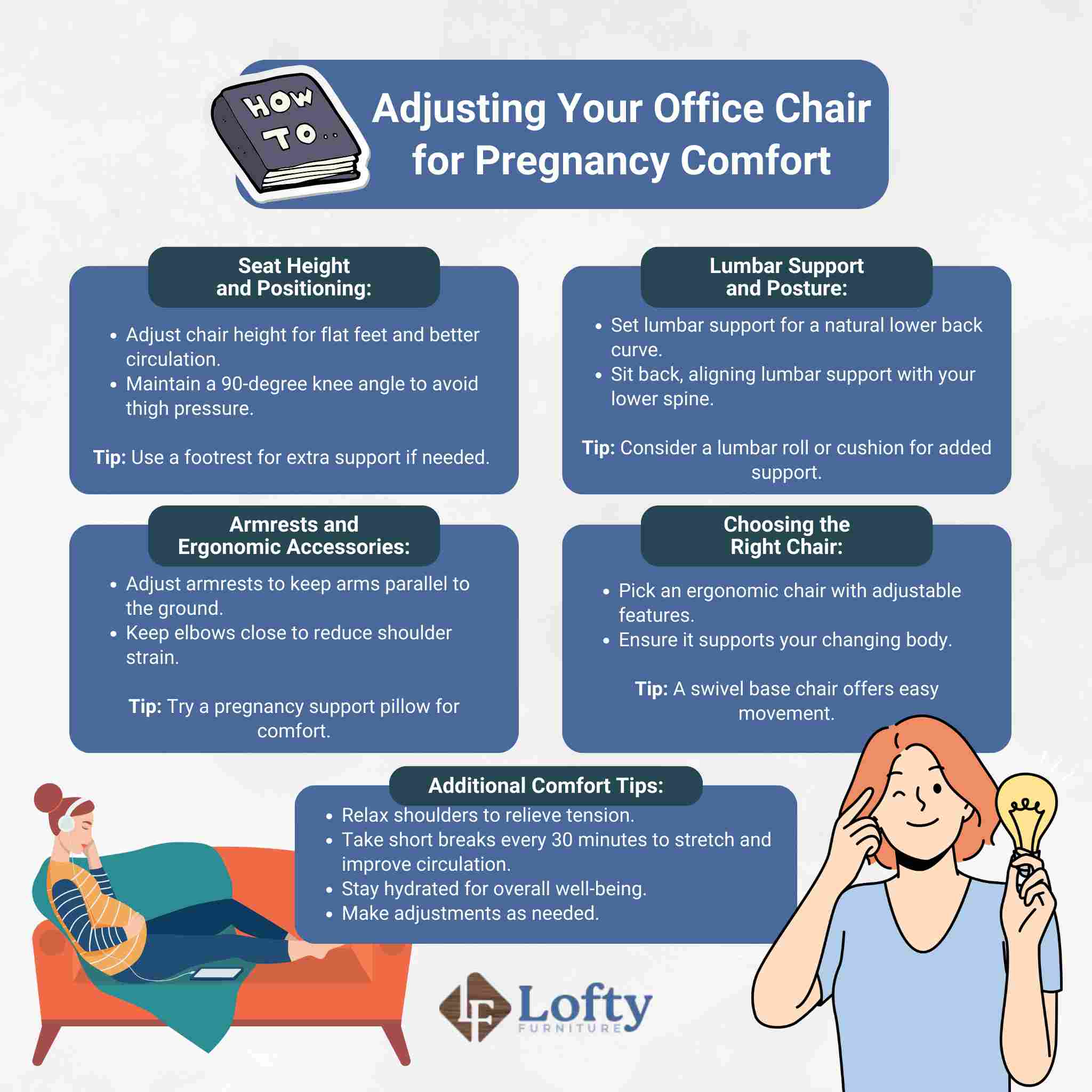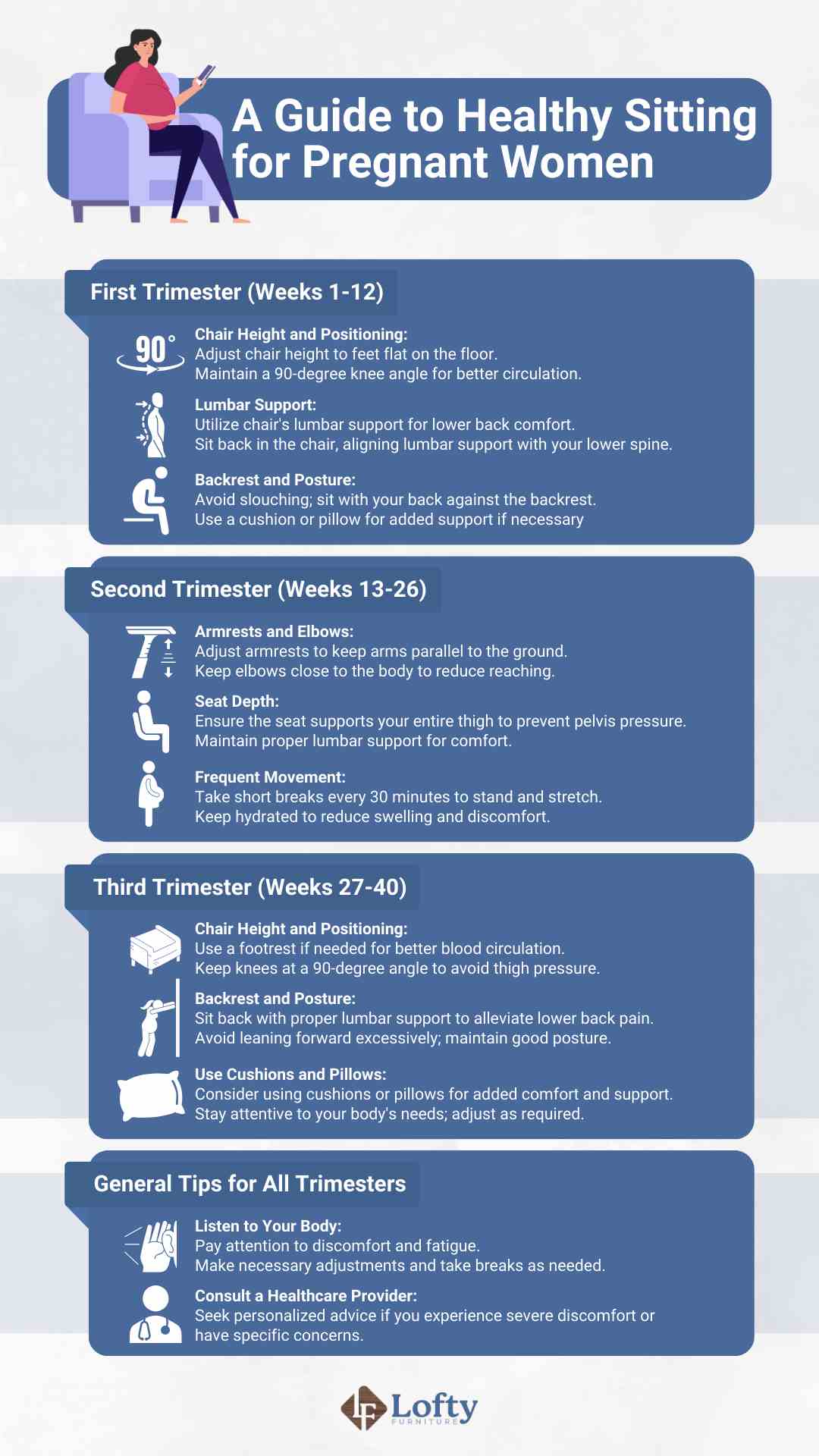Did you know that over 75% of pregnant women experience back pain during their pregnancy? Sitting in an office chair for long hours can exacerbate this discomfort and negatively affect their body. Expectant mothers must prioritize their comfort and well-being while working. Let’s explore how to sit in office chairs during pregnancy.
During pregnancy, sitting in an office chair requires comfort and support. Opt for an ergonomic chair with proper lumbar support, utilize cushions to support your lower back, and take regular breaks to stand, stretch, and promote circulation.
In this article, we will guide you on how to sit properly in your office chair during pregnancy, ensuring a safe and supportive posture. Additionally, we will address specific concerns such as swollen feet and legs, pelvic pain, and sciatica.
Pregnancy and Ergonomics
When you are pregnant, your body goes through various changes that can affect your posture and body mechanics. These changes may include a shift in your center of gravity and an increase in the curvature of your spine.

Changes in Posture and Body Mechanics
During pregnancy, a woman’s body undergoes significant physiological changes that influence her posture and body mechanics, particularly when sitting.
One notable change is the development of lumbar lordosis, an increased curvature in the lower back, as the growing baby bump shifts the center of gravity forward. This can result in heightened pressure on the lower back while sitting.
Additionally, hormonal changes lead to the widening of the hips, affecting how pregnant women sit and necessitating adjustments for comfort. The forward tilt of the pelvis and a shift in the center of gravity further impact sitting posture, causing pregnant women to lean back slightly for balance.
The body’s preparation for childbirth involves hormonal fluctuations, such as releasing relaxin, which loosens ligaments and joints. While this increased flexibility is essential for childbirth, it can affect joint stability and requires pregnant women to be mindful of their sitting positions.
Impact of Prolonged Sitting on Pregnancy Health
Sitting for extended periods during pregnancy can hurt overall health and well-being. Maintaining a sedentary lifestyle while pregnant has been linked to various health concerns. For instance, prolonged sitting has been associated with an increased risk of gestational diabetes, as it affects glucose metabolism in the body.
Additionally, excessive sitting during pregnancy can contribute to weight gain, which may lead to complications such as high blood pressure and increased strain on joints. It is also important to note that sitting for long periods can impede blood circulation, potentially causing swelling and discomfort.
Furthermore, the added weight and changes in posture during pregnancy can exacerbate back pain when seated for extended periods.
Importance of Ergonomic Office Chairs for Pregnant Women
During pregnancy, it is crucial to prioritize your prenatal health and create a comfortable work environment.
Investing in ergonomic office furniture, such as an adjustable office chair or kneeling chair designed for pregnant women, can significantly enhance your productivity and overall well-being. These chairs provide optimal support to accommodate your changing body shape and alleviate back pain commonly experienced during pregnancy.
With adjustable features like lumbar support and seat height, you can customize the chair to fit your specific needs at different stages of pregnancy. A comfortable work environment is essential for maintaining focus and reducing discomfort, allowing you to stay productive throughout the day.
Negative Effects of Improper Sitting During Pregnancy

Avoiding proper sitting positions during pregnancy can negatively affect your body and overall comfort. It is crucial to prioritize your pregnancy health by understanding the negative consequences of improper sitting.
Sitting in an incorrect posture puts excessive strain on your back, neck, and shoulders, leading to discomfort and pain. This can further exacerbate existing conditions such as sciatica or pelvic girdle pain.
Improper sitting also affects the circulation in your legs, increasing the risk of developing varicose veins or deep vein thrombosis. It may even lead to swelling in the ankles and feet due to poor blood flow.
Furthermore, slouching or leaning forward while seated can compress your organs, causing digestive issues like heartburn or constipation.
To ensure comfort and safety during pregnancy, consider investing in ergonomic office chairs for pregnant women. These chairs are adjustable and offer proper lumbar support to maintain a neutral spine alignment. They help distribute weight evenly and promote good posture while reducing pressure points.
Remember that taking care of yourself during pregnancy is essential for your and your baby’s well-being. Using ergonomic office chairs and practicing proper sitting techniques can minimize discomfort and maximize productivity throughout your workday.
Building the Perfect Sit
To build the perfect sitting position during pregnancy, start by adjusting your seat height and positioning to ensure optimal comfort and support. Pay special attention to maintaining proper lumbar support and posture, which can significantly reduce back pain and discomfort.

Seat Height and Positioning
Ensure your office chair is adjusted to the proper height and positioned correctly for optimum comfort during pregnancy. Chair ergonomics play a crucial role in maintaining proper posture and reducing discomfort.
Start by adjusting the seat height so your feet are flat on the floor, knees at a 90-degree angle, and thighs parallel to the ground. This promotes good blood circulation and helps prevent swelling in your legs.
Optimal positioning involves sitting back in the chair with your back fully supported by the backrest. Avoid slouching or leaning forward, as this can strain your lower back and lead to discomfort.
Additionally, ensure the armrests are comfortable, allowing your arms to rest while typing or performing tasks.
Lumbar Support and Posture
Now that you have adjusted your office chair to the correct height and positioning, let’s focus on another important aspect of sitting during pregnancy: lumbar support and posture.
As your baby grows, it is crucial to maintain proper alignment and support for your lower back to alleviate any potential discomfort or back pain.
To achieve this, make sure your office chair has adequate support. Look for chairs specifically designed with adjustable lumbar support or consider using a separate lumbar pillow if needed.
Sit straight with your back against the chair, avoiding slouching or leaning forward excessively. Keep both feet flat on the floor and distribute your weight evenly between them.
Armrests and Ergonomic Accessories
Ensure armrests are appropriately adjusted to support your arms and shoulders. This will help alleviate strain and tension in those areas.
Additionally, consider using ergonomic footrests to support and promote proper blood circulation in your legs. Wrist support is crucial during pregnancy, so invest in a wrist rest or cushion that helps keep your wrists in a neutral position while typing or using the mouse.
Proper keyboard height is essential for maintaining good posture and preventing discomfort. Adjust it so that your elbows are at a 90-degree angle and your forearms are parallel to the floor.
Lastly, pay attention to the backrest position of your office chair. It should be adjusted to support the natural curve of your spine, promoting proper alignment and reducing back pain.
Choosing the Right Chair for Comfort and Safety
When you are pregnant, it is essential to find a chair with a pregnancy-friendly design. Look for comfortable chairs such as plush cushioning and padded armrests. These features provide support and reduce pressure on your body.
Adjustable options are also important. They allow you to customize the chair’s height and tilt according to your needs. Proper body alignment is crucial during pregnancy, so choose a chair that promotes good posture. Look for one that offers lumbar support and an adjustable backrest. These features will help alleviate any back pain or discomfort you may experience.
Remember, sitting for long periods can be challenging during pregnancy. However, selecting the right chair with these features can make all the difference in ensuring your comfort and safety throughout the day.
How To Sit in Office Chair During Pregnancy
Ensure your office chair is adjusted for optimal comfort and support during pregnancy. Pregnancy can bring discomfort and changes in your body, making it essential to take extra care when sitting for extended periods.
To maintain a healthy posture, consider the following pregnancy sitting positions:
Step 1: Sit straight with your back against the chair, avoid crossing your legs as it can restrict blood flow, and keep both feet flat on the floor or use a footrest if needed.
Step 2: Adjusting your office chair correctly prevents back pain and maintains proper blood circulation. Adjust the seat height so your feet are firmly planted on the ground. This will help distribute weight evenly and prevent strain on your lower back.
Step 3: Adjust the backrest angle to support the natural curve of your spine while providing stability. Additionally, consider using a lumbar pillow or cushion for added support.
Remember to take regular breaks from sitting by standing up and stretching every hour or so. This helps improve blood circulation and reduces swelling in your legs and feet.
Lastly, listen to your body’s signals – if you experience discomfort or pain while sitting, adjust accordingly.
Here is a video you can also use as a reference to make sitting in office chairs more comfortable during pregnancy:
How to Sit in Office Chair During Pregnancy: Beyond the Basic Sit
To go beyond the basic sit in your office chair during pregnancy, it is important to incorporate exercises and stretches that promote comfort. Regular breaks and movement are crucial for improving circulation and reducing discomfort.
Exercises and Stretches for Office Chair Comfort
Sitting comfortably in your office chair during pregnancy can be enhanced by incorporating exercises and stretches into your routine. Not only will this help alleviate discomfort, but they will also promote better circulation and posture.
Start by doing gentle neck rolls, and shoulder shrugs to release tension in those areas. Then, try pelvic tilts to strengthen your core muscles and improve stability.
Stretching your legs and ankles is also important to prevent swelling and cramping. You can do ankle rolls or extend your legs straight in front of you and flex your feet towards the ceiling.
Lastly, remember proper breathing techniques to relax both body and mind.
Regular Breaks and Movement
Regular breaks and moving around frequently throughout the day are crucial for maintaining good circulation and preventing muscle stiffness, especially during pregnancy. Research studies have shown that even just a few minutes of stretching or walking every hour can significantly reduce the risk of developing musculoskeletal discomfort.
Staying active during pregnancy is vital for promoting blood circulation and overall well-being. Pregnancy movement breaks help alleviate physical discomfort and improve mental focus and productivity.
Remember to listen to your body’s cues and take breaks whenever you feel tired or uncomfortable.
Hydration and Nutrition for Office Settings
Staying well-hydrated and nourished throughout the workday is crucial for maintaining a healthy and vibrant pregnancy. In an office setting, it is easy to forget proper nutrition and hydration while focusing on work tasks. However, taking care of yourself during this critical time is essential.
Start by bringing nutritious and convenient office snacks such as fresh fruits, nuts, or yogurt cups. These can help curb hunger between meals and provide essential vitamins and minerals.
Additionally, drink plenty of water and consider meal prepping healthy meals at home so that you have nutritious options readily available during lunch breaks.
Choosing Pregnancy-Friendly Office Accessories
Creating a comfortable and supportive workspace is crucial during pregnancy. Start by considering a pregnancy-friendly desk that allows you to adjust its height, ensuring proper alignment and reducing strain on your body.
Additionally, investing in comfortable footwear can help alleviate swelling or discomfort in your feet. An adjustable keyboard is another essential accessory as it allows you to maintain a neutral wrist position while typing, preventing unnecessary strain on your joints.
Don’t forget about a supportive backrest for your chair, which will provide much-needed lumbar support. Finally, ensure proper lighting in your workspace to reduce eye strain and promote productivity.
By incorporating these pregnancy-friendly office accessories into your workspace, you can create an environment that supports both your comfort and productivity during this particular time.
Addressing Specific Concerns
During the first trimester of pregnancy, you may experience challenges such as morning sickness and fatigue that can affect your ability to sit comfortably in an office chair.

First Trimester Challenges
Despite the initial challenges, to sit comfortably in an office chair during pregnancy first trimester can be achieved with a few simple adjustments. Pregnancy symptoms like morning sickness and fatigue management may make finding a comfortable sitting position difficult. However, some strategies can help alleviate these discomforts.
First, ensure you have proper prenatal care to address any specific concerns or symptoms you may be experiencing. This will provide reassurance and give you access to valuable resources and support.
Managing morning sickness by eating small, frequent meals and avoiding triggers can help reduce nausea while at your desk. Short breaks throughout the day to stretch your legs and relax can combat fatigue and improve overall comfort.
Lastly, emotional changes are normal during pregnancy, so finding ways to destress and maintain a positive mindset is critical in creating a comfortable environment for yourself in the office chair.
Third Trimester Adjustments
With your body growing and changing in the final months, finding a comfortable position to relax and alleviate discomfort can become quite challenging.
During the third trimester of pregnancy, you may face various challenges, such as managing back pain, supporting your belly, finding comfortable positions, and maintaining good circulation.
Try sitting on an ergonomic chair that provides proper lumbar support to manage back pain. You can also use a small pillow or cushion behind your lower back for support.
Supporting your belly is crucial during this stage. Place a pregnancy pillow or a rolled-up towel under your belly while sitting to relieve pressure. Finding comfortable positions is key to relieving discomfort. Experiment with different chair adjustments, such as reclining slightly or using an adjustable footrest to elevate your feet.
Lastly, maintaining good circulation is essential for preventing swelling in the legs and feet. Avoid crossing your legs and take frequent breaks to walk around or stretch.
Remember to listen to your body and adjust as needed throughout the day. Here’s a recap of the tips you can follow for every semester:

Sitting Pretty: A Pregnancy-Approved Guide to Office Chair Comfort
In conclusion, it is crucial to prioritize posture when you sit in an office chair during pregnancy to ensure your and your baby’s well-being. By following the guidelines outlined in this article, such as maintaining a neutral spine position and utilizing ergonomic supports, you can minimize discomfort and reduce the risk of developing musculoskeletal issues.
Remember, a little effort now can go a long way in promoting a healthy pregnancy journey.


